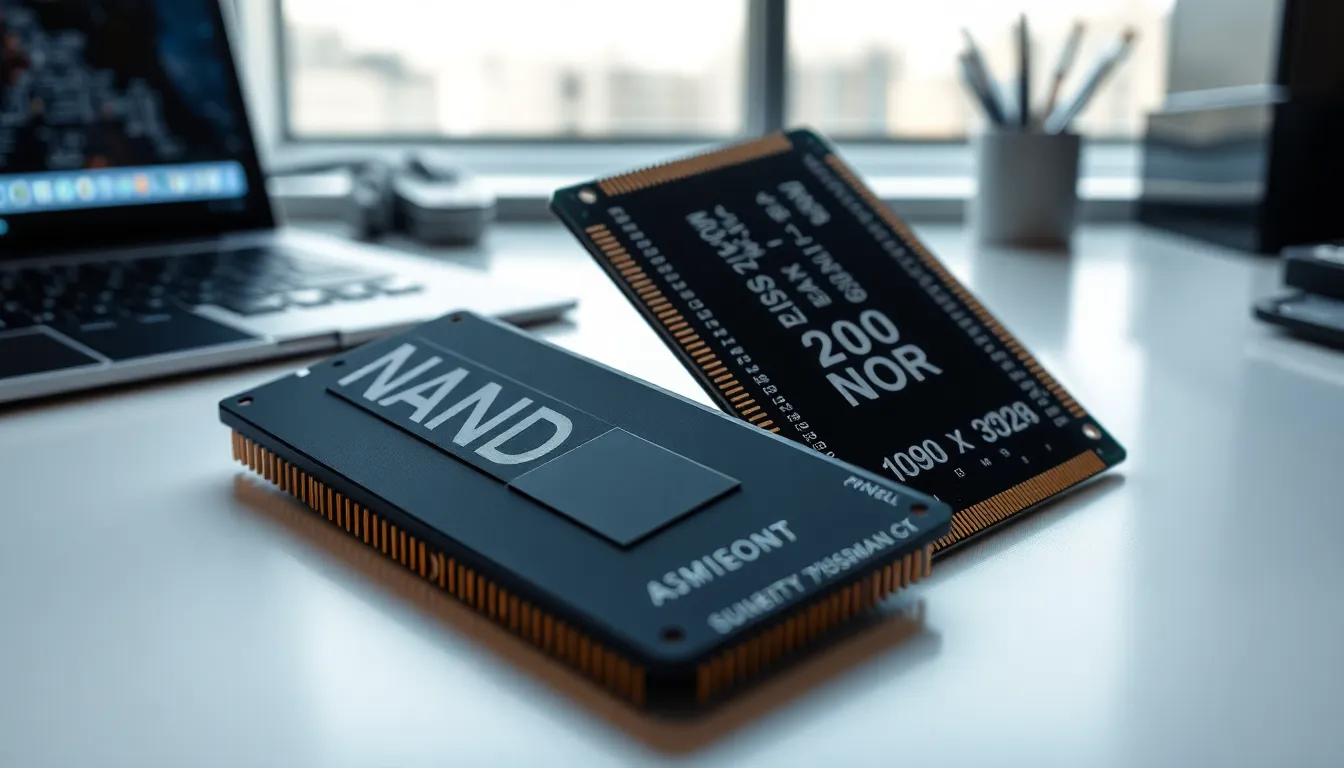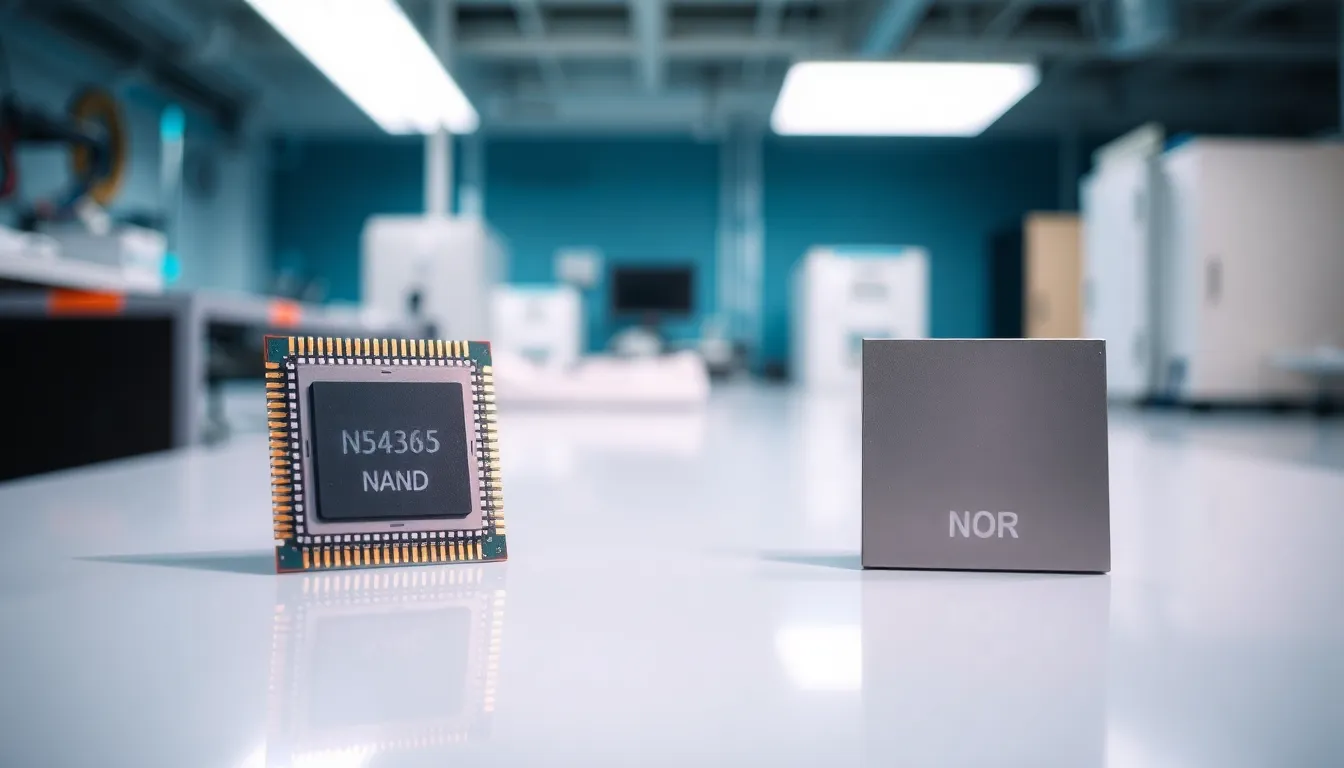In a world where speed is king, flash technology reigns supreme. Imagine zipping through data like a cheetah on roller skates—now that’s the kind of performance everyone dreams of! Whether it’s boosting your computer’s responsiveness or supercharging data centers, flash technology is the secret sauce that turns sluggish systems into lightning-fast marvels.
Flash Technology
Flash technology plays a crucial role in modern computing, significantly improving data access speeds and overall performance. It utilizes non-volatile memory, allowing data retention without a power supply. Systems using flash memory benefit from quicker boot times, faster file transfers, and reduced latency.
Numerous applications rely on flash technology, including solid-state drives (SSDs), USB flash drives, and memory cards. SSDs, for instance, outperform traditional hard drives in both speed and reliability. Enterprises frequently adopt these devices to manage large datasets efficiently.
In terms of architecture, flash memory is built on NAND technology, featuring multiple types such as SLC, MLC, TLC, and QLC. SLC offers the best performance and endurance but at a higher cost, while QLC provides greater storage capacity but lower write endurance. This variety serves diverse market requirements, providing options for both high-performance computing and cost-effective solutions.
Flash memory also incorporates wear leveling and error correction mechanisms to ensure data integrity and longevity. Manufacturers continuously innovate within this space, pushing for increased capacity and reduced costs. Market trends indicate an ongoing shift towards flash-based solutions in smartphones, laptops, and data centers.
As technology advances, further developments in flash technology promise even more enhancements. Emerging technologies like 3D NAND and storage-class memory extend the capabilities of flash, enabling applications that demand higher speeds and more efficiency. Market analysts predict significant growth in this sector, affirming its vital role in future computing landscapes.
Types of Flash Technology


Flash technology encompasses various types, each designed for specific applications. The two main types of flash memory are NAND flash and NOR flash, both serving unique purposes within the tech landscape.
NAND Flash
NAND flash memory dominates the storage market due to its high density and cost-effectiveness. This type excels in solid-state drives, USB flash drives, and memory cards. Performance relies on the arrangement of memory cells while offering a better price-to-capacity ratio than other technologies. Multi-level cell (MLC), triple-level cell (TLC), and quad-level cell (QLC) variations exist, providing different trade-offs between speed, endurance, and storage capacity for users. Wear leveling and error correction techniques enhance NAND’s reliability, making it suitable for both consumer and enterprise-grade solutions.
NOR Flash
NOR flash memory stands out for its random access capability, allowing faster read speeds compared to NAND. This type is commonly used in embedded systems, providing reliable storage for firmware and application code. Individual memory cells in NOR flash can be directly accessed, enabling quick data retrieval. Given its higher performance, NOR flash often comes at an elevated cost per gigabyte. Applications also include automotive systems, smart devices, and telecommunications equipment where data integrity is crucial. Despite its higher price and lower density compared to NAND, NOR remains essential for specific high-performance scenarios.
Applications of Flash Technology
Flash technology finds extensive use across various sectors due to its speed and efficiency. Its impact reaches both consumer electronics and enterprise solutions.
Consumer Electronics
Consumer electronics heavily utilize flash technology, especially in smartphones and tablets. Solid-state drives (SSDs) enhance performance, offering faster boot times, quicker app launches, and smooth multitasking experiences. Digital cameras rely on memory cards powered by flash storage, allowing seamless high-resolution photo captures. USB flash drives provide portable storage solutions, enabling quick file transfers between devices. Smart TVs and gaming consoles leverage flash memory to improve loading speeds and reduce latency. Overall, flash technology significantly elevates user experiences across a range of devices.
Enterprise Solutions
Enterprise solutions embrace flash technology for its reliability and speed advantages. Data centers, for instance, benefit from SSDs that outperform traditional hard drives, delivering rapid data access and lower power consumption. Businesses rely on flash storage for database management, allowing real-time data processing essential for operational efficiency. Virtualization technology incorporates flash storage for scalability and improved performance. Additionally, cloud service providers leverage flash technology to enhance storage solutions, meeting the demands for speed and access in today’s competitive market. Flash technology thus plays a crucial role in optimizing enterprise operations.
Advantages of Flash Technology
Flash technology offers several key benefits that enhance performance and efficiency. Speed represents one of the most significant advantages, as it dramatically reduces data access and retrieval times. Users experience quicker boot times and fast file transfers, improving overall productivity.
Durability emerges as another vital benefit of flash technology. Unlike traditional hard drives, which utilize moving parts, flash memory relies on non-volatile storage, minimizing the risk of mechanical failure. This factor contributes to a longer lifespan for devices such as solid-state drives and USB flash drives.
Energy efficiency also plays a crucial role in the advantages of flash technology. Flash storage consumes less power compared to spinning hard drives. Data centers benefit from this aspect, leading to reduced operational costs and a smaller environmental impact.
Scalability and flexibility are additional strengths that make flash technology appealing. Various types of NAND flash, including SLC, MLC, TLC, and QLC, cater to diverse market requirements. This adaptability ensures that manufacturers can provide tailored solutions for consumer electronics, enterprise solutions, and embedded systems.
Cost-effectiveness remains another notable advantage. While flash memory may have higher upfront costs, its long-term benefits, such as lower power consumption and increased reliability, lead to overall savings. Consumers and businesses alike gain from this investment over time.
Performance in high-demand environments also highlights the capabilities of flash technology. Applications requiring rapid data access, such as virtualization and cloud computing, benefit immensely from flash storage solutions. Enhanced user experiences mark a significant factor when deploying flash in consumer electronics and enterprise systems alike.
Challenges and Limitations of Flash Technology
Flash technology faces several challenges and limitations that impact its effectiveness in various applications. One major limitation involves endurance. Flash memory cells wear out over time, especially with intensive write and erase cycles. Alongside this, write amplification reduces the lifespan of flash drives as they experience more data writing than necessary, leading to faster degradation.
Another challenge is cost. Although prices have decreased, flash components remain more expensive than traditional hard drives. This can affect affordability for large-scale storage deployments, especially for small businesses seeking budget-friendly solutions. Additionally, data recovery becomes challenging when flash memory fails. Unlike traditional hard drives, retrieving lost data from flash storage can be complex and often requires specialized services.
Speed comes into play regarding latency. While flash technology excels in fast data access, certain high-performance applications may still benefit from alternative memory solutions. For instance, some systems may not fully utilize flash’s capabilities, especially in read-heavy workloads.
Moreover, the capacity of flash storage devices can be limited compared to hard drives. Although advancements in 3D NAND technology have increased density, there are still constraints that restrict the maximum available storage. Compatibility with legacy systems also presents issues, as some older hardware cannot support newer flash technology formats.
Addressing security concerns is vital as well. Flash memory can be susceptible to vulnerabilities, risking data breaches if not properly managed. Implementing robust encryption and secure data handling practices is essential to mitigate these risks.
Flash technology, despite its advantages, faces significant challenges. Endurance, cost, data recovery difficulties, latency, capacity constraints, and security issues are pivotal considerations. Understanding these limitations helps in making informed choices regarding the use of flash technology across various sectors.
Future Trends in Flash Technology
Emerging trends in flash technology prioritize advancements in speed and capacity. Innovations are driving the development of 3D NAND technology, which enhances storage density and boosts overall performance. Companies are investing heavily in multi-level cell, triple-level cell, and quad-level cell configurations, optimizing the balance between speed, endurance, and capacity.
Data-centric architectures are becoming prominent, with flash storage playing a pivotal role in real-time analytics. As processing demands increase, flash offers rapid data retrieval that meets the needs of businesses in various sectors. Adoption of storage-class memory is also on the rise, combining the benefits of both traditional memory and storage solutions.
Sustainability is increasingly important; energy-efficient flash storage solutions minimize environmental impact while lowering operational costs. Flash technology is evolving toward low-power consumption, which aligns with the growing emphasis on green practices across industries.
Artificial intelligence and machine learning integration further enhance data management capabilities. Systems utilizing flash technology can process vast amounts of data quickly, improving decision-making and operational efficiency. In consumer applications, flash continues to evolve, ensuring user experiences in devices such as smartphones, tablets, and gaming consoles remain seamless and responsive.
Security developments are influencing flash technology trends, with a focus on encryption and robust data protection measures. Ensuring data integrity and confidentiality is crucial as cyber threats grow. The convergence of flash technology with cloud computing is also reshaping data storage strategies, providing scalable solutions for businesses to manage extensive datasets effectively.
Overall, trends in flash technology indicate a significant shift towards faster, more efficient, and reliable solutions that meet the evolving demands of both consumers and enterprises.
